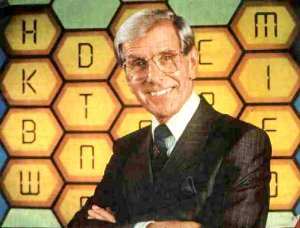Blockbusters: Difference between revisions
No edit summary |
No edit summary |
||
| Line 43: | Line 43: | ||
==External Links== | ==External Links== | ||
* [http://www.ukgameshows.com/index.php/Blockbusters UK Game Show Page: ''Blockbusters''] (additional info on the British version) | |||
* [http://www.gameshow-galaxy.net/block1.htm Game Show Galaxy: ''Blockbusters''] (additional info on the US version) | * [http://www.gameshow-galaxy.net/block1.htm Game Show Galaxy: ''Blockbusters''] (additional info on the US version) | ||
Revision as of 19:30, 2 April 2006

Blockbusters was a television game show in which contestants answered trivia questions to complete a path across a game board of hexagons.
Broadcast History
Blockbusters was originally a US show, but was most successful in the UK, where it was shown from 1983 to 1993 on the ITV network with Bob Holness hosting. The show, made by Central Independent Television, was played by sixth form students with prizes accrued for the students and their colleges. The theme music for this version was by Ed Welch. As a career actor, Holness played up the role of being an 'old duffer' to the young contestants that won him a cult following amongst students. After finishing on ITV, the show continued for a few years on the satellite channel Sky One, though some ITV regions continued to show the series.
Subsequent series have been made for adult contestants, broadcast by BBC Two in 1997 (presented by Michael Aspel) and Sky One again in 2000 (presented by Liza Tarbuck). These versions failed to capture the same degree of popularity as the Holness incarnation.
Other Countries
United Sates
The original US version of Blockbusters, hosted by Bill Cullen, ran from 27th October 1980, to 23rd April 1982. A second version, hosted by Bill Rafferty, ran from 5th January to 1st May 1987. Both versions aired on NBC. Reruns of the Cullen version currently air on GSN, and GSN also has aired the Rafferty version (it aired most recently from April through November 2005).
Australia
The Australian version of Blockbusters was broadcast on the Seven Network, where players from two schools competed over the course of a week (five episodes), in a rolling format - where games could be started in the middle of an episode, and stopped and continued on the next episode. The school team earning the most points (based on questions answered from the main game, except tie-breaks) won a major prize for their school, such as an encyclopedia. The show was hosted by Michael Pope.
Germany
There was also a German version called Super Grips.
Main Game
A solo player competed against a "family pair" that consisted of two related contestants (married couples were not allowed), thus setting out to prove if two heads really were better than one.
The game board consisted of 20 interlocking hexagons, arranged in five columns of four. Each hexagon contained a letter of the alphabet. A contestant would choose one of the letters, and would be asked a general-knowledge trivia question whose correct answer began with the chosen letter. (A typical question was something like, "What 'P' is a musical instrument with 88 keys?" The answer would be a piano.) In the UK, the phrasing that contestants would use to ask for a letter has entered the language, eg. "Can I have a 'P' please, Bob?".
The game began with a toss-up question to play for control of the board, starting with a letter that was chosen at random. The first contestant to buzz in with the correct answer gained control of that hexagon and was given the chance to choose another one. If the contestant answered incorrectly, the opposing team or player was given a chance to answer it. If nobody answered it correctly, the host asked another question whose answer began with that same letter.
The object of the game for the solo player was to complete a vertical connection from the top of the board to the bottom; that required at least four correct answers. The object for the family pair was to make a horizontal connection from the left side of the board to the right; that required at least five correct answers. The first player or team to win two games won the match.
Gold Runs
The winner of the match went on to play the Gold Run bonus round; if the family pair won, only one player on the team could play. The board consisted of a pattern of hexagons similar to that of the main game, but the hexagons had 1 to 5 letters inside them; those letters were the initials of the correct answer. (For instance, if a contestant chose "CSI" and the host said "The university merged in 1976", the correct answer would be "College of Staten Island.") If a contestant guessed correctly, the hexagon turned gold. However, if the contestant guessed incorrectly or passed, it turned black, blocking the player's path; it was then up to the contestant to work around it. The object was to horizontally connect the left and right sides of the board within 60 seconds (or before blocking off all possible horizontal connections).
The winner of Gold Run won a special prize, usually a holiday, for completing the run. For every unsuccessful attempt, money was awarded for each correct answer. Defending champions could keep going for up to five matches undefeated, in order to win an even bigger prize. In later series, presumably so they could get through more contestants over the course of a series, this was reduced to three consecutive successes.
Karl's Rockbusters
See main article: Rockbusters
External Links
- UK Game Show Page: Blockbusters (additional info on the British version)
- Game Show Galaxy: Blockbusters (additional info on the US version)